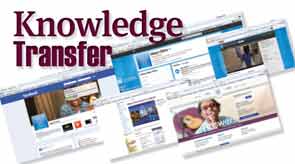
It was nine o’clock on a Tuesday morning in June 2008. Lee A. Aase, manager of media relations at the Mayo Clinic in Rochester, Minn., learned of a study involving one of Mayo’s endocrinologists, Victor Montori, MD, that was going to be published that afternoon in the Journal of the American Medical Association.
Explore This Issue
September 2013At 10:20 am, Aase began videotaping an interview with Dr. Montori about the study. By noon, the video was posted on Mayo’s YouTube channel, embedded in its news blog, and e-mailed to journalists. The following day, the Wall Street Journal health blog embedded the video within its story.
After several years of experimenting with social media as a vehicle for disseminating health care information, Mayo launched the Center for Social Media in July 2010. Its mission was to expand social media from a public relations and marketing application to a robust communication tool for patient care, research and education. Since then, the center has surpassed its original goal, evolving into a social media expert for health care providers nationwide.
“Our use of social media was an outgrowth of our media relations work,” said Aase, now director of the center.
With 10 employees, the center places content in the path of the interested public. Hundreds of videos showcase physicians offering generic information about diseases or effective treatments or patients discussing their medical condition and inpatient experiences at Mayo.
Everyone seems to benefit. Sharing information is therapeutic for some patients. Online visitors receive updated, accurate information. Even physicians are pleased because their videotaped quotes are never inaccurate or misleading.
“One of the things frustrating for physicians is quotes taken out of context,” he said. “We use flip video cameras and iPhone cameras as a way of capturing the expertise of our physicians instead of hassling them to write blogs for us. It’s relatively painless.”
Keep It Real
Although the center has editorial discretion, Aase said all videos are posted on YouTube in their entirety, creating an authentic viewer experience. Comments are never edited. The same holds true for negative comments posted on Facebook or Twitter.
“If there weren’t negative comments on our Facebook page, then people would say it’s a whitewash, that we’re stripping out all the negative stuff,” said Aase.
Facebook and Twitter are monitored by employees for 12 hours each weekday. On weekends, employees rotate, checking postings several times throughout the day. Although the center encourages visitors to express their opinions, it prevents them from monopolizing Mayo’s Facebook page, he said, adding that most patient issues blow over in a day or two. Developing a long-range perspective is a key part of the center’s strategy.
So is partnering with patients, added Farris K. Timimi, MD, the center’s medical director.
“For me to say with a straight face that only a physician can have expertise in a patient disease begins to lose credibility,” said Dr. Timimi, also program director for the Advanced Heart Failure and Transplant Fellowship Program at Mayo. “Patients are the living experts of their disease.”
He said the majority of Mayo’s patients live online. He believes that physicians have a moral obligation to participate in online chats, especially considering the low cost of participation and profound scalability of health care information. Although the Health Insurance Portability and Accountability Act of 1996 applies to health care information both on and offline, he said the center trains providers on how to avoid crossing blurred lines between sharing health information and practicing medicine.
Last year, one of Mayo’s transplant cardiologists, Brooks S. Edwards, MD, participated in the center’s Twitter chat that highlighted the importance of organ donation, which coincided with Facebook’s organ donor recruitment campaign. That same day, Mayo released a video of Dr. Edwards on its YouTube channel walking people through the process of changing their status to be an organ donor. The reach and penetration was “incredibly profound,” Dr. Timimi said.
“[Dr. Edwards] had never been an advocate of social media and has become very involved in Twitter,” he said. “The number of frank conversations that occurred in that Twitter chat—how many lives have been changed—really moved Brooks to be a strong advocate of social media participation.”
Extended Reach
Using social media successfully is a learned, not innate, skill. The Center for Social Media offers social media guidelines for physicians and Social Media Residency training classes twice a year at each of Mayo’s three locations for any health care employee. Likewise, it also formed the Social Media Health Network, a membership group of 120 organizations that share ideas and access Mayo’s training materials.
In the future, Dr. Timimi believes the center will lead the way in social media’s evolution, helping doctors prescribe social media opportunities and tools for patients, such as specific Facebook chats or apps for losing weight.
Until then, the center will continue recreating and inventing social media learning opportunities.
“If you put good content in the hands of [people] online, when they become a patient, they’ll come to you for their medical care,” said Dr. Timimi. “Our obligation as providers is to walk with patients on their online journey.”
Reprinted with permission from the American College of Rheumatology.
Leave a Reply